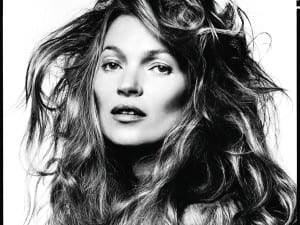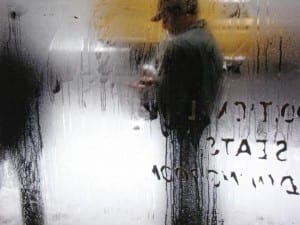Review by Laura Barone,, a candidate for the MA in Art History at Richmond the American International University in London.
It’s only April, but what a year for feminist art in London: from Cindy Sherman at Sprueth Magers to Louise Bourgeois and Tracy Emin at Hauser and Wirth, to Nancy Spero currently at The Serpentine, it has certainly been a strong few months. I am a Fantasy at PayneShurvell featuring Margaret Harrison and the performance artist duo The Girls (Zoe Sinclair and Andrea Blood) energetically continues this trend. Curator Beverley Knowles has deftly combined several of Harrison’s ironic gender-bending series of media icons with The Girls and their creepily and wonderfully Sherman-esque ‘static’ performances.
Harrison, by now well known for having a show shut down in 1971 by police on the cause of indecency, has not at all lost her provocative touch. Although Fantasy Footballer (1998), a drawing of a footballer with breasts, exposed garters – and a penis- is not as shocking to a 21st century audience, Harrison continues to critically engage with societal constructions of masculinity and femininity through the appealing façade of irony. There are 15 pieces of Harrison’s paintings and drawings, roughly divided into three groups. The first, six Marilyns (1994), are an unsettling homage to the very starlet that declared the namesake of the show, “I am a fantasy.” The image of a freckled young, almost girlish Marilyn evokes anxiety due to the setting – her eyes are closed and she is sleeping. Marilyn is nice to look at when she looks back, but, here she is a child and viewers are treading on the uneasy grounds of naivety, the formations of what will become a fantasy.
Where Harrison really excels is with her watercolours, coloured pencil, and graphite on paper of celebrities and superheroes. Olympia: Model Role (Hattie McDaniel ‘Mammy’/Vivien Leigh ‘Scarlett O’Hara’) (2010) racially recasts Édouard Manet’s infamously provocative nude with characters from Gone with the Wind, this time, with Olympia played by Mammy and the black maid played by Scarlett. Several Captain America (1997) pieces burst with generous breasts and toned calf muscles – in the same figure. High heels, garters, matching outfits – Captain America is outfitted in everything a female superhero should be; his masculinity has been ‘compromised’ with attributes of the kind of damsels in distress he should be saving, but he doesn’t seem to noticed. The comic-book inspired works are reminiscent of Roy Lichtenstein, but Harrison’s choice of a much smaller scale and her use of watercolour on paper plays with the idea of secret, sensual images that one can hide away for personal use. If that’s so, what kind gendered gaze is taking these away to consume in private?
The Girls contribute one piece, Diamonds and Toads (2011), an installation of a large, two-person, circular couch piece that looks like it belongs in a French boudoir. Its padded interior is a deep, luscious colour, but upon closer inspection, some of the fabric is ripped, and suddenly, it could be an extra set-piece at a funeral home, or something dirtied and discarded, left on the side of the road for garbage clean-up. When Sinclair and Blood are present (the evenings of 14 April and 5, 21 May), they lounge in the couch, motionless, in elaborate dresses and mannequin-like masks where their eyes eerily open and close. The masks allow them to watch viewers in a voyeuristic way, to gaze unrestrained, but their horizontal position within a gallery space equally subjects them to scrutiny. When the artists are not present, the Rococo-like couch and costumes still will be, jarringly strange in a white-cube, yet still serving to emphasize women’s ability to slip in and out of prescribed trappings of femininity like ruffles and florals and fabrics.
This is not militant feminist art. In fact, both Harrison and The Girls employ well rehearsed themes of feminism like gender as a socially constructed category, the ‘putting on’ of femininity rather than something biological, and women’s objectification through their equation with consumer products and food (Harrison’s witty drawing Available in Other Colours (2007) depicts a blonde bombshell with a cell phone as a face). Yet, after so many ‘waves’ of feminism, these sorts of works still seem so poignant and contemporaneous, challenging viewers to consider that no matter how progressive they ascribe themselves to be, their consumption of media, history, and advertisement does quite a lot to counter that. The good news: it seems that Harrison, Sinclair, and Blood are having a good time at it all.
Margaret Harrison and The Girls, I am a Fantasy, continues at PayneShurvell until 21 May 2011. The Girls performances will be 5 May and 21 May, 6:30-7:30. For more information see www.payneshurvell.com
Images:
Hes only a bunny boy but hes quite nice really
Archival print on paper with hand finishing
Edition of 100
2011
Courtesy PayneShurvell
Captain America
Watercolour and graphite on paper
1971/1997
Courtesy PayneShurvell





